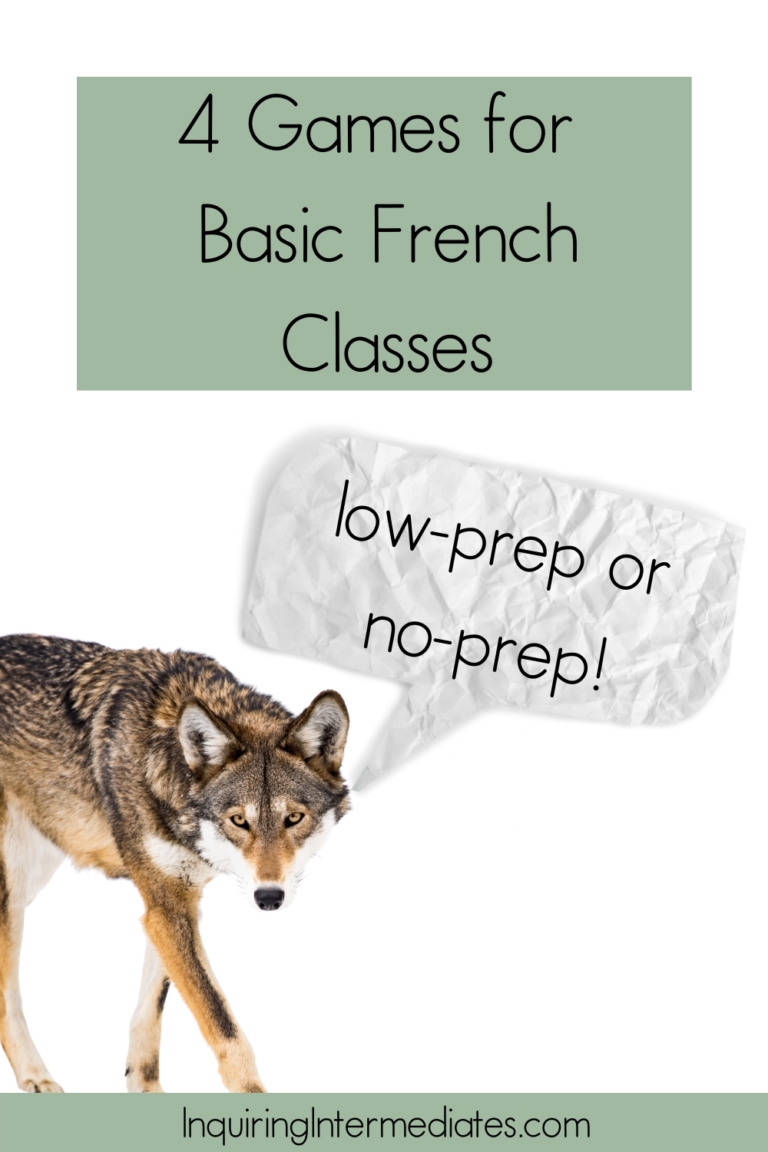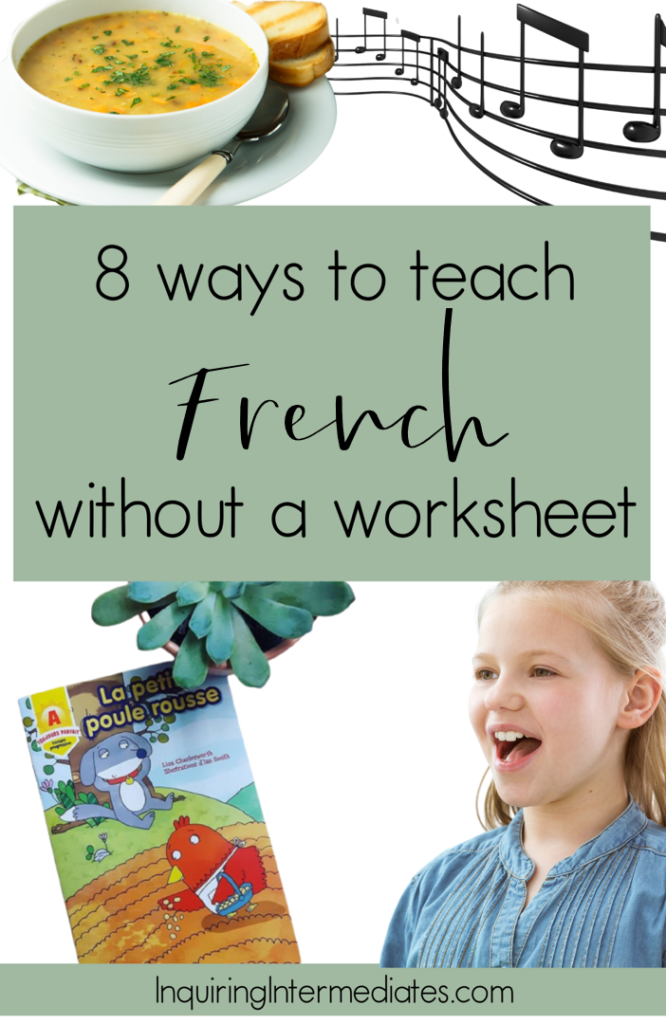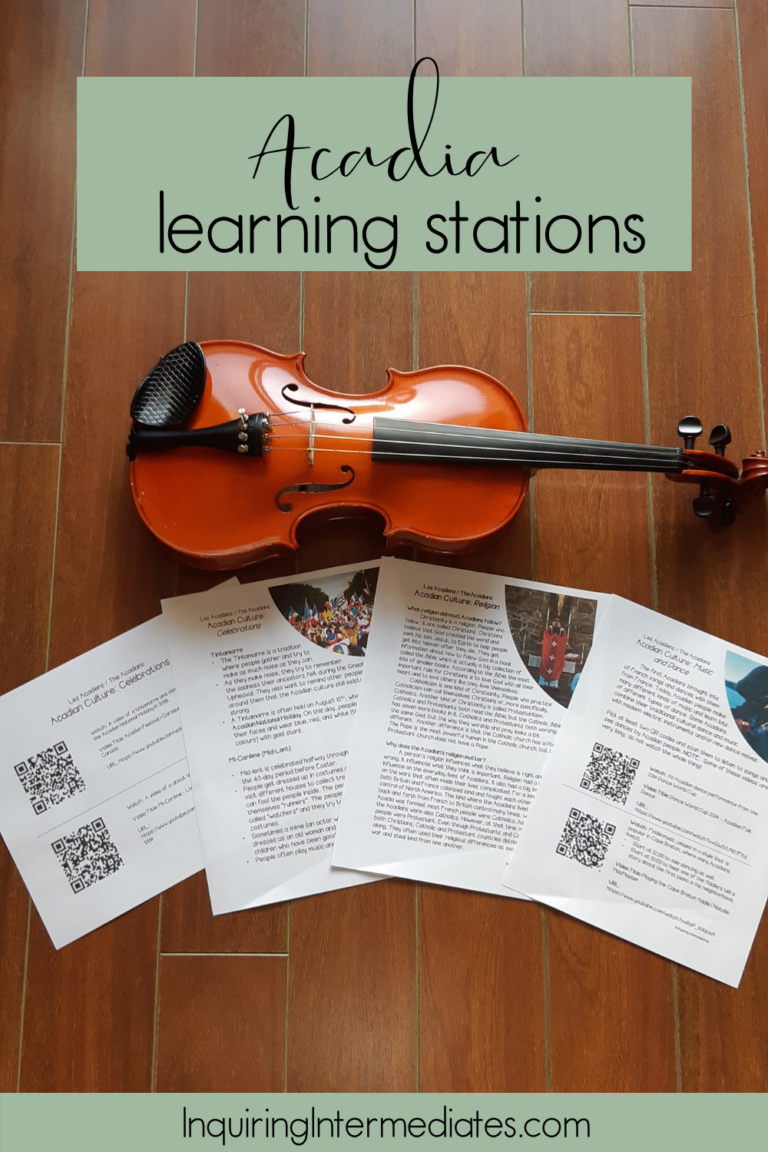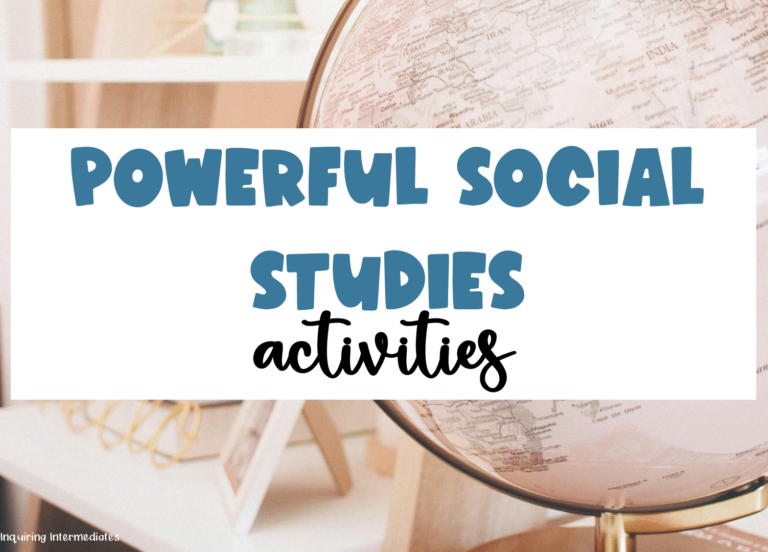Don’t get me wrong, I think worksheets still have a place in French because they allow for scaffolded reading and writing activities. However, there are plenty of paperless ways to teach French without a worksheet and engage your students in meaningful learning!
Games for French Class
Gamifying learning is almost always a good idea! Good French instruction isn’t made up of vocabulary lists and grammar lessons. Language learning that sticks is developed through a communicative approach that allows kids to practice speaking, reading, and writing while focusing on getting their meaning across, not being perfect. Games are the perfect way to practice authentic communication and teach French without a worksheet.

French Oral Language Games
Quelle heure est-il, Monsieur Loup?
Playing What Time is it, Mr. Wolf? en français is a quick and easy brain and body break for the kids… and they are practicing their French numbers at the same time! On sunny days, we love to pop out for a quick round or two on the blacktop. It’s a game that students are generally familiar with, and, if they’re not, it’s easy to learn.
Beach Ball Toss
Here’s a super-simple oral language game, and all you need is a ball or stuffed animal to throw! Students toss a soft item around the room, and, when they catch it, say a French word. In grade five, where my students are just beginning to learn French, they can say any French word. The only caveat is that they can’t say one someone else already said. With more advanced French speakers, you might give them a category. For example, you might have them list things they’d see outdoors or words that start with a certain letter.
Personally, I have found that speaking French in the real world can get me a little tongue-tied. Beach Ball Toss is a way for kids to get used to thinking quickly on their feet in French!
French Grammar Games: Verbathons
Verbathons are team competitions where groups work together to put subjects and verb conjugations in the right order as fast as possible. You can use pocket charts or magnets; I have printed and laminated a few sets for “être” and “avoir” and like to have the kids stick them to the exterior of our portable on sunny days. I’ve also seen people put magnets on them and stick them on the whiteboard, or tuck the cards into various pocket charts.
Here’s how to run a verbathon:
- Each team lines up behind an emptied book bin that has a set of verb cards in it.
- The first person in the line grabs a card, runs to the board, and sticks it roughly where they think it would fall in the conjugation.
- They run back, and the next person repeats the process.
- If students see a mistake in the order, they can fix the mistake but cannot grab a new card on that turn. They are encouraged to cheer their team members on, but they cannot give any instructions about where the cards should go.
French Reading & Vocabulary Games: Slap Games
French Slap games are one of my students’ favourite activities for when we have a few extra minutes. All I do is split the class in half, project the game on the board, and play! Each slide has a phrase on top and the bottom section is split into two parts with one image in each section. One player from each team approaches the board and tries to be the first one to slap right picture when I change the slides. The kids get very invested in these games… so much so that we now take the clock off the wall before we begin because it has fallen off on more than one occasion! I have this version with emotions vocabulary available in my TPT store.
Songs for French Class
Songs can stick with you, so learning French songs is a great way to teach French without a worksheet! In fact, no paper is required at all!
Remember all those kids’ songs you sang as a kid while learning your alphabet? Those same kinds of songs are available in French all over youtube, and they are a great tool to use when teaching French to beginners! They’re a super catchy way to get your students practicing their vocabulary. I have found that my fifth-graders are the perfect age to enjoy these songs “ironically”, so hyping them up sarcastically before they begin is an easy way to get them on board. Usually, a class develops a few favourites and will even request them at times. You can also use French music to celebrate things like birthdays or to mark transition times in your schedule.
When teaching French to kids, try to make it interactive whenever possible! See if you can make the most of your music time by doing more than just singing.
Extension Ideas for Listening to French Music
- Hold up numbers on their fingers while a number song plays.
- Jump in place when you hear a colour you are wearing (I stole this one from my sponsor teacher during my student teaching practicum!). This song is a bit slower if you’re looking for a less hoppy version.
- Pause the song partway through and see how long they can keep singing without music (or who can say the next line if you’re not allowed to sing).
Read Aloud Books for French Class
Let me just say that I am not a fluent French speaker. My students know this bevcause I usually start off the year by telling them a little bit about my own French-learning journey. However, I try not to let my feelings of self-consciousness stop me from reading aloud in French to my students. I keep the texts very simple: think early-readers likes these Toujours parfait books or very repetitive books. And I practice a few times before I read them aloud! Sometimes I do need to check the pronunciation and/or meaning of a few words.
When I read aloud to my students, I remind them that my pronunciation isn’t perfect but I’m trying my best! They need to see us taking risks if we’re going to ask them to take risks too. I let them know they aren’t expected to translate every sentence and word. The goal is to understand the big idea. We stop frequently and ask questions like: “What do you think is happening here?”, “How do you know?”, “What words or phrases do you recognize?”, or “In this context, what might ______ mean?”
Comprehending basic stories is one of the Curricular Competencies for Grade 5 Core French in BC, where I teach. Read alouds are a great way to foster that skill! They build confidence for when kids have to read on their own later. Sometimes I’ll give them some questions to answer on paper, but often I won’t. Read alouds and discussions are great on their own to help you teach French without a worksheet!
I’ve also enjoyed reading Elephant and Piggie books with my kids in French (although they’re called Elephant and Rosie in French). I read it aloud all the way through once, engaging in meaning-building discussions along the way. Yes, several of my students know the stories from having read them in English – that’s actually great! It lets them focus on the French words and phrases, not the storyline. After we’ve read it all the way through, we read just the first few pages again. Students write and illustrate their own versions of those pages, swapping out a word or two, in their French journals. We do it comic-style to save paper. Every day, we continue this process with a few pages at a time until the kids have their very own Elephant and Piggie-inspired story!
French Writing Routine: French Journals
French Journals make it easy to teach French without a worksheet. They are such an easy morning-work activity and they provide meaningful writing and reading practice for students. I write the prompt on the board and students raise their hands when they want me to check their work. In the beginning of the year, I write the prompt almost entirely in English and students more or less just copy it down and fill in the blanks. By the end of the year, the prompts are almost entirely in French. I am planning on writing a separate blog post about French Journals and the kinds of prompts I use, so check back soon for some ideas!
Simple French Writing Assignment: Write a Reader
Remember those early readers you had as a kid? The cat sat on the mat. The cat had a hat. Blah blah blah blah… Beginning French students can absolutely write stories like that! By June, I want my students to know vocabulary for at least the following concepts:
- Introductions (names, ages)
- Numbers
- Feelings
- To wear
- To have
- Likes and dislikes
We call these our “no excuse” phrases. They’re the ones that I want them to know without looking for in duotangs or the Word Wall (although I’m not too concerned about the spelling of the longer words). With even a small vocabulary, they can write and illustrate basic storybooks.
French Alphabet Poems
I teach fifth grade, and in BC that’s the first year that kids learn French. When teaching French to beginniners, you have got to start from scratch! A few years ago, I bought these alphabet poems on a whim from a kindergarten French immersion teacher on TPT. I wasn’t sure if the kids would buy into them because they were created for much younger students, but they love them! I print off the miniature versions of the poems so each student gets their own alphabet set for their duotangs.
Each poem introduces a letter and gives examples of words that start with that letter. I project the illustrated poems and kids illustrate their own versions as we learn them. Then we repeat it together, just like in a kindergarten class! They love volunteering to try and read the new poem or show off how they’ve memorized an earlier one.
With four-ish vocabulary words per poem, kids have learned roughly 100 French words by the end of the alphabet! That gives them so many possibilities for their reading and writing later.
Exploring Francophone Cultural Traditions in French Class
Field Trips and Learning Stations
Virtual Field Trips
Teaching French culture through virtual field trips is a great way to teach French without a worksheet!
Understanding Francophone cultures is an important part of our French education. By exploring Instagram or TikTok accounts for Francophone attractions, students can learn about Francophone cultures and their celebrations. I do this by projecting on the whiteboard and discussing what we see. You may want to create a powerpoint document to house screenshots and embedded youtube videos, because some of the platforms make it difficult to show the content you want without seeing ads or comments that may not be appropriate for your students. You can also explore virtual field trips offered by Google or cobble together some youtube videos! For extra fun, pretend to fly there with a video like this one!
Learning Stations
I love learning stations! They’re such a fun way to get kids to explore different aspects of a topic at their own pace.
When creating learning stations, you can include pictures, videos, audio recordings, primary sources, and articles. They’re a great way to let students learn from a variety of different sources. In my Acadia Learning Stations, for example, there are articles about Acadian history and culture. I have also included QR codes to videos where students can hear an Acadian dialect of French, watch traditional Acadian dances, learn about cultural celebrations, and listen to music from Mi’kmaq artists (whose territory Acadians historically resided on).
Take a Real Field Trip!
When I was in high school, my French class took a bus downtown for lunch at a French restaurant. Our teacher challenged us to speak French all the way there and we had to order en français. I remember feeling so intimidated but excited at the same time! There may also be French cultural centres or heritage sites in your community that offer field trips. Take a look at what’s in your area!
Explore French Food
If you are able, consider cooking or baking French food with your students! My sister still talks about when her French teacher brought the class Quebec-style pea soup. If you are considering that particular dish, just make sure all your students are OK to eat pork, or make a pork-free version instead.
Do you teach French? If so, what are you favourite ways to teach French without a worksheet?



